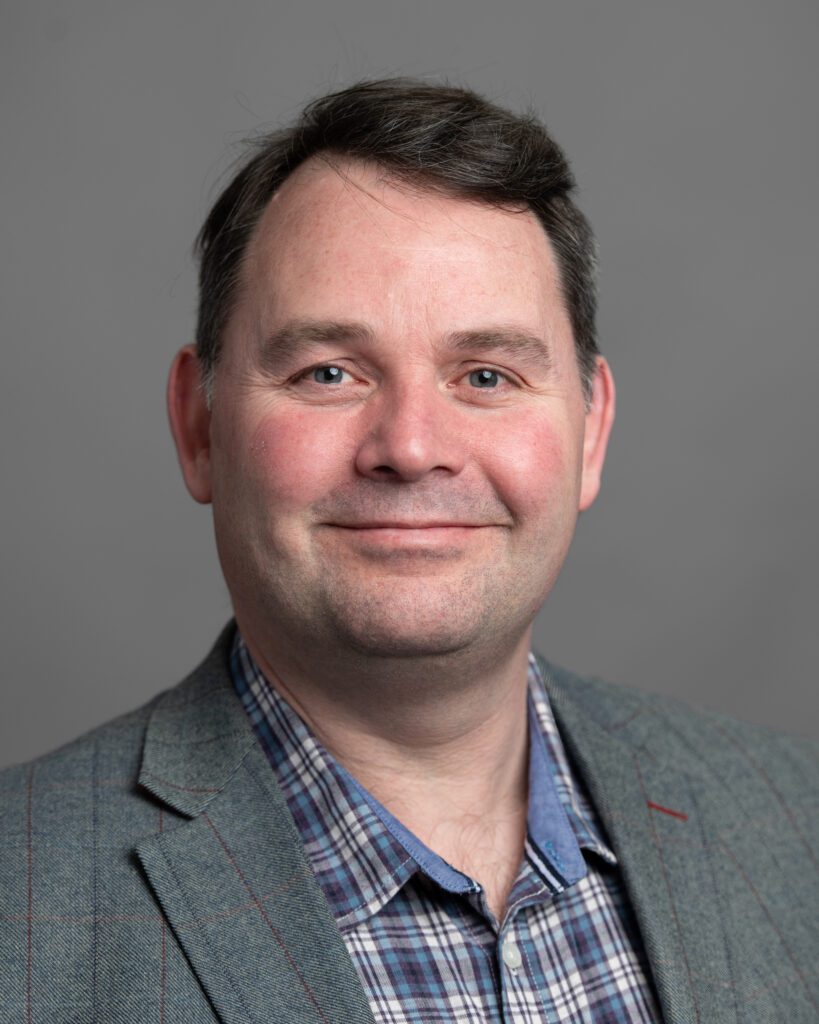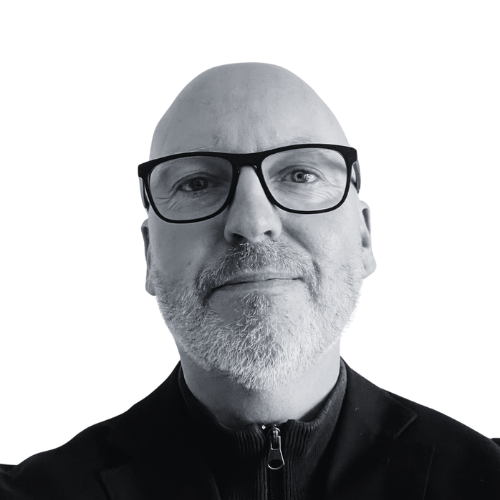Artificial Intelligence
Net zero
Quantum
Wise words and waggishness… December 2025
Reading time: 5 mins
Jon Pugh, a director of photonic integrated circuits and quantum technology at Optica, talks to BI Foresight about why he is optimistic for the future of quantum photonics
For Jon Pugh, an expert in quantum engineering and a leading voice in photonic integrated circuits (PICs) and quantum technology at Optica, this interview is a role reversal. Usually, he’s the one asking the questions, quizzing members of Optica’s growing optics and photonics community. But today, he’s offering his own insights into why photonic quantum networks are closer than we think, how they’ll transform financial transactions, and what’s next for commercialisation.
“We’ll see the first quantum-secure financial transactions within five years,” says Pugh, sitting in a carriage-like cubicle in the Bristol Innovations Zone, an innovation hub next to Bristol’s Temple Meads station. “Quantum-safe networks are becoming a commercial necessity. We’re already seeing early-stage quantum key distribution (QKD) deployments. Banks like JP Morgan Chase, HSBC, and the European Central Bank are leading the way, and we’re seeing a surge in investment and partnerships to make this a reality.”
It’s not just financial services. Telefónica’s collaboration with Spanish healthcare company Vithas has seen the operator implement a QKD system to secure communications between two hospitals in Madrid. This initiative, which encrypts sensitive data such as patient medical records to make them immune to potential future quantum computing attacks, was showcased at the recent Mobile World Congress in Barcelona.
It’s an indicator that next-generation quantum-safe communications are moving from the lab to real-world applications, says Pugh. Banks should be next, but Pugh adds that scaling these networks globally presents a fundamental challenge – fibre loss limits the distance over which quantum-secure data can travel.

“Quantum networks can’t just be built from scratch,” Pugh explains. “They have to work over existing aging fibre infrastructure, which means we need quantum repeaters to extend their range.” Unlike classical repeaters that amplify signals, quantum repeaters must preserve the delicate quantum states that underpin encryption, a technological hurdle that researchers and companies are working to overcome.
Companies like Qunnect, MemQ, and Toshiba are racing to bring viable quantum repeaters to market, with early implementations expected within the next decade.
“This is the missing piece,” Pugh says. “Once we have functional, scalable quantum repeaters, quantum networks will move from city-wide deployments to global, end-to-end encryption for financial transactions, healthcare, and national security.”
Pugh also points to the work being done within conurbations, with quantum networks already taking shape in urban testbeds. Cities like New York and Chicago have established early-stage quantum-safe communication networks, serving as blueprints for wider deployment. In Europe, the Quantum Internet Alliance is accelerating efforts to integrate QKD across national borders, while major telecom providers are exploring how to retrofit existing infrastructure with quantum-safe capabilities.
“This is where research meets commercial reality,” Pugh says. “We’re seeing industry and government-backed projects proving that quantum security isn’t just a theoretical upgrade, it’s a necessity for safeguarding critical data.”
Despite these advancements, Pugh warns that the clock is ticking on quantum security. The anticipated arrival of Q-Day – the moment when a cryptographically relevant quantum computer can break existing encryption – is an increasing concern for governments and industries. “We don’t know exactly when it will happen, but we do know we’re not ready,” he says. “By the time a quantum computer can break RSA encryption, we’ll already be too late to secure vast amounts of sensitive data that’s being harvested today.”
Governments and corporations are scrambling to prepare. The US National Institute of Standards and Technology (NIST) has been working on post-quantum cryptography (PQC) standards, while the EU and China are pushing ahead with quantum-safe network initiatives that combine both PQC and QKD. Yet Pugh argues that policy alone won’t be enough – the challenge is ensuring that industries act fast enough to transition to quantum-resistant security measures before Q-Day arrives.
“This is why we’re seeing companies making strategic moves to control both quantum computing and quantum security,” he says, pointing to IonQ’s recent acquisition of ID Quantique, a leading player in quantum-safe encryption. “It’s a significant moment. We now have a quantum computing giant bringing quantum cryptography under its umbrella, which shows how intertwined these fields have become.”
For Pugh, this signals that hardware and security must evolve in parallel. “IonQ acquiring ID Quantique means we’re entering an era where quantum computing firms are also investing in the antidote to their own breakthroughs,” he says. “We’re seeing a shift where companies aren’t just focused on building the most powerful quantum processors, they’re preparing for the security challenges that come with them.”
Yet while acquisitions like this highlight industry urgency, Pugh believes that most companies are still underestimating the timeline. “Quantum computers are advancing faster than expected,” he notes. “The real question is, will our security infrastructure be in place before it’s too late?”
A big question for Pugh is: who can manufacture quantum photonic components at scale? He points to PsiQuantum’s recent breakthrough partnership with GlobalFoundries as a turning point.
“For years, quantum photonic components were made in low volumes, with custom fabrication methods, making them expensive,” says Pugh. “PsiQuantum has changed that by partnering with an established strong semiconductor foundry. Now, quantum photonic chips can be produced with accuracy, scalability, and repeatability.”
He suggests this is critical for commercialisation, as without standardised fabrication, quantum start-ups working with PICs will struggle to scale.
“Right now, most quantum start-ups are running into the same problem – prototyping is slow, expensive, and reliant on research cleanrooms rather than full-scale fabs,” he explains. “If we want to see practical quantum networks and quantum computing systems integrated into industries, we need more tier-one foundries stepping into the space.”
Semiconductor giants like TSMC and Intel are also exploring quantum photonics, while European initiatives are investing in advanced photonic integration. But Pugh warns that geopolitical factors could play a significant role in shaping the quantum supply chain.
“There’s a reason why the US and China are pushing hard on sovereign quantum capabilities,” he says. “We’re entering an era where the ability to manufacture quantum components, whether for computing, networking, or sensing, will be a strategic advantage, not just a commercial opportunity.”
This race is driving an influx of investment into quantum manufacturing. In the UK, the National Quantum Technologies Programme is funding research, training and facilities making it a “go-to” place for quantum companies to locate their quantum activities. In Europe, alongside the existing Quantum Technologies Flagship, there is €400m of funding for advanced chip pilot facilities, while in the US, the CHIPS Act had earmarked billions for quantum semiconductor research, but that is under threat with President Trump describing it as a “horrible, horrible thing”. Meanwhile, private investors are pouring capital into quantum start-ups, hoping to back the next Nvidia of the quantum era.
“The money is flowing, but the real question is whether the supply chain can keep up,” Pugh adds. “We’re finally seeing quantum technology hit the commercialisation tipping point, but without mass manufacturing capabilities, the entire industry risks bottlenecks.”
This supply chain challenge could determine which regions lead the next wave of quantum breakthroughs. If scalable quantum manufacturing remains concentrated in the US and China, European and British quantum companies may struggle to compete.
“We need to think long-term,” Pugh concludes. “The winners in quantum won’t just be the ones making the best algorithms or qubits, it will be the companies and countries that can build, scale, and deploy at a level that matches classical computing.”
Optica 2025 Quantum Industry Summit
Optica brings the largest players in the field together annually to discuss their preferred future for the industry in a collaborative atmosphere. The Fourth Edition of the Optica Quantum Industry Summit will take place at MShed in Bristol on 11-12 November 2025 alongside hosts Bristol Innovations at the University of Bristol and the West of England Combined Authority.
This year’s summit will concentrate on the advancement of photonics technologies (including lasers, optics, PICs, detectors, and equipment), quantum computing, communications, system integration, memory storage, and metrology.

Working as a technology journalist and writer since 1989, Marc has written for a wide range of titles on technology, business, education, politics and sustainability, with work appearing in The Guardian, The Register, New Statesman, Computer Weekly and many more.
Quantum
Reading time: 10 mins
Quantum
Reading time: 10 mins
Quantum
Reading time: 11 mins
Robotics
Reading time: 1 mins
Quantum
Reading time: 3 mins